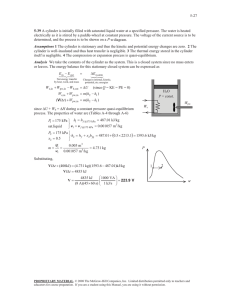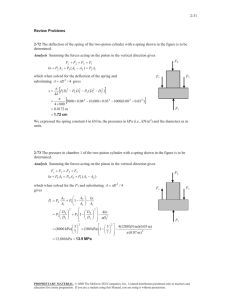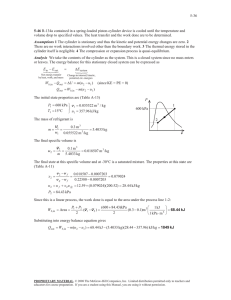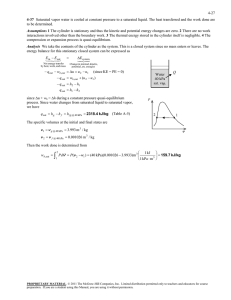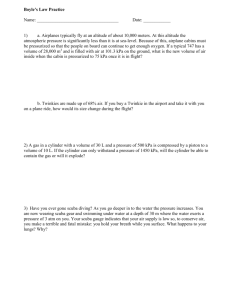High-Reynolds Number Aeroacoustic Testing Under
advertisement
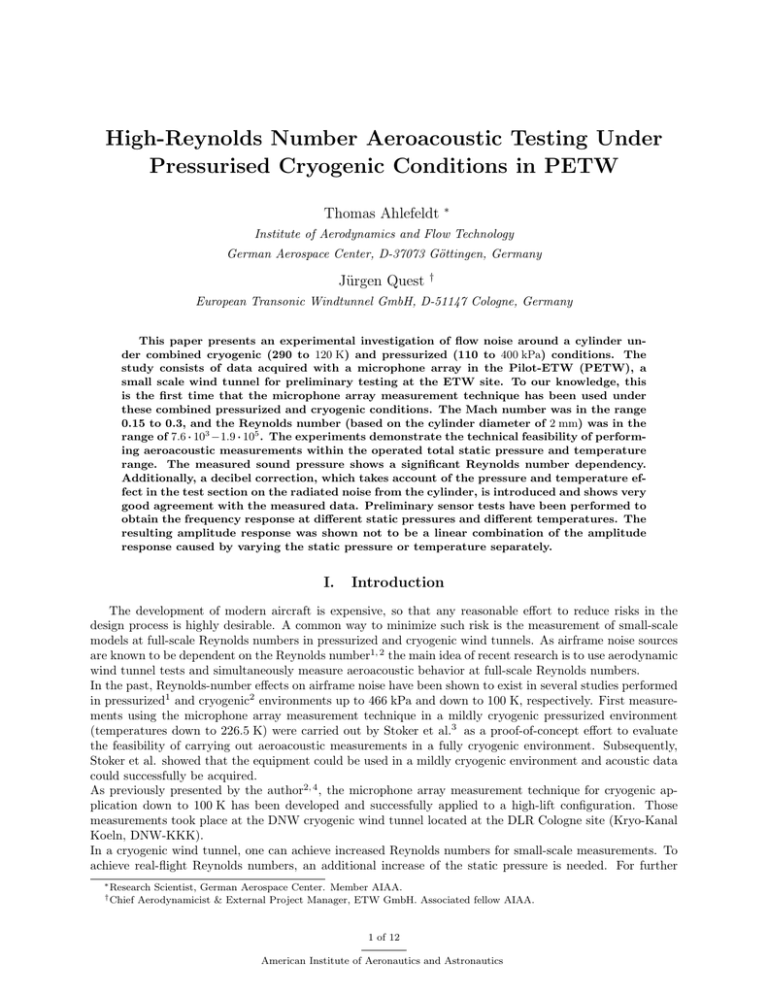
High-Reynolds Number Aeroacoustic Testing Under Pressurised Cryogenic Conditions in PETW Thomas Ahlefeldt ∗ Institute of Aerodynamics and Flow Technology German Aerospace Center, D-37073 Göttingen, Germany Jürgen Quest † European Transonic Windtunnel GmbH, D-51147 Cologne, Germany This paper presents an experimental investigation of flow noise around a cylinder under combined cryogenic (290 to 120 K) and pressurized (110 to 400 kPa) conditions. The study consists of data acquired with a microphone array in the Pilot-ETW (PETW), a small scale wind tunnel for preliminary testing at the ETW site. To our knowledge, this is the first time that the microphone array measurement technique has been used under these combined pressurized and cryogenic conditions. The Mach number was in the range 0.15 to 0.3, and the Reynolds number (based on the cylinder diameter of 2 mm) was in the range of 7.6 · 103 −1.9 · 105 . The experiments demonstrate the technical feasibility of performing aeroacoustic measurements within the operated total static pressure and temperature range. The measured sound pressure shows a significant Reynolds number dependency. Additionally, a decibel correction, which takes account of the pressure and temperature effect in the test section on the radiated noise from the cylinder, is introduced and shows very good agreement with the measured data. Preliminary sensor tests have been performed to obtain the frequency response at different static pressures and different temperatures. The resulting amplitude response was shown not to be a linear combination of the amplitude response caused by varying the static pressure or temperature separately. I. Introduction The development of modern aircraft is expensive, so that any reasonable effort to reduce risks in the design process is highly desirable. A common way to minimize such risk is the measurement of small-scale models at full-scale Reynolds numbers in pressurized and cryogenic wind tunnels. As airframe noise sources are known to be dependent on the Reynolds number1, 2 the main idea of recent research is to use aerodynamic wind tunnel tests and simultaneously measure aeroacoustic behavior at full-scale Reynolds numbers. In the past, Reynolds-number effects on airframe noise have been shown to exist in several studies performed in pressurized1 and cryogenic2 environments up to 466 kPa and down to 100 K, respectively. First measurements using the microphone array measurement technique in a mildly cryogenic pressurized environment (temperatures down to 226.5 K) were carried out by Stoker et al.3 as a proof-of-concept effort to evaluate the feasibility of carrying out aeroacoustic measurements in a fully cryogenic environment. Subsequently, Stoker et al. showed that the equipment could be used in a mildly cryogenic environment and acoustic data could successfully be acquired. As previously presented by the author2, 4 , the microphone array measurement technique for cryogenic application down to 100 K has been developed and successfully applied to a high-lift configuration. Those measurements took place at the DNW cryogenic wind tunnel located at the DLR Cologne site (Kryo-Kanal Koeln, DNW-KKK). In a cryogenic wind tunnel, one can achieve increased Reynolds numbers for small-scale measurements. To achieve real-flight Reynolds numbers, an additional increase of the static pressure is needed. For further ∗ Research † Chief Scientist, German Aerospace Center. Member AIAA. Aerodynamicist & External Project Manager, ETW GmbH. Associated fellow AIAA. 1 of 12 American Institute of Aeronautics and Astronautics development, the DLR is planning to perform microphone array measurements at the wind tunnel of the European Transonic Windtunnel GmbH (ETW). The ETW can provide real-flight Reynolds numbers by virtue of both decreased temperature and increased pressure. As one part of the project, aeroacoustic tests were conducted at the Pilot-ETW (PETW), a small scale wind tunnel at the ETW site used for preliminary testing. A microphone array consisting of 12 microphones was used for aeroacoustic tests on noise generated from flow around a cylinder under combined cryogenic (290 K to 120 K) and pressurized (110 kPa to 400 kPa) conditions. To our knowledge, this is the first time that the microphone array measurement technique has been used under these pressurized and cryogenic conditions. The preparation included preliminary sensor tests to obtain the frequency response at different static pressures and different temperatures. This paper is divided into two parts. The first part describes the sensor calibration performed in the cryogenic vessel of the ETW. The second part deals with the aeroacoustic testing in the PETW. It also includes the algorithms and the corrections for the cryogenic and pressurized test section. II. Sensor calibration At ambient conditions, high precision microphones show a linear frequency response. However, this response does not maintain its linear behavior when temperature and static pressure are varied. Until now, this non-linear response has only been investigated separately for each of temperature and static pressure variation. Tests on Brüel&Kjær type 4136 microphones at various static pressures were conducted by Boeing5 and showed some rather dramatic frequency response characteristic at high pressures. Those measurements culminated the design of the special sensor type 4138-W-001, which shows a less dramatic frequency response. Tests on Brüel&Kjær sensor type 4944 at various temperatures were performed by Brüel&Kjær and the ETW GmbH, from which the new cryogenic-type sensor 4944A arose. This microphone type was used as a reference for the temperature calibration of the microphones used for the microphone array measurements in the DNW-KKK.4 In this work, a calibration measurement was performed using four of the 1/4-inch Brüel&Kjær cryogenic condenser microphones of type 4944A. The frequency response was measured in the range from 500 Hz to 100 kHz under combined cryogenic and pressurized conditions. An excitation signal was simulated by electrostatic actuators in the cryogenic vessel of the ETW. The static pressure was varied in six steps from 110 kPa to 450 kPa and the temperature was altered in 7 steps in the range of 290 K to 120 K. The temperature was obtained via Pt100-sensors mounted on the microphone. The frequency response of the four microphones showed a negligible standard deviation for all measurement points and frequencies up to 70 kHz. Thus the mean value of the amplitude frequency responses of the four microphones is used in the following. The figures 1–3 show amplitude responses in decibels normalized to the amplitude response at T = 290 K and pstat = 110 kPa. Figure 1 shows the results for T = 290 K and various static pressures from 110 kPa to 450 kPa. For increased static pressures, an increased frequency dependency can be observed. The shape of the response curves becomes wavy and shows a change in response that goes from −14.7 dB to +2.9 dB for a static pressure of 450 kPa. Each frequency response shows one maximum (in the range of 20 kHz to 22 kHz) and one minimum (in the range of 53 kHz to 60 kHz). Figure 2 shows the results for pstat = 110 kPa and various temperatures from 120 K to 290 K. When temperature is decreased, an increased frequency dependency can also be observed and the shape of the response curves becomes wavy with changes from −8.7 dB to +7.5 dB for a temperature of 120 K. The frequency responses for that case show two maxima (in the range of 22 kHz to 25 kHz e.g. 75 kHz to 90 kHz) and one minimum (in the range of 42 kHz to 56 kHz). In contrast to the frequency response shown for changing static pressures, here differences in both the shape and the frequency ranges where the maxima and minima of the curvy responses appear can be found. The combined influence of the non-ambient static pressure and non-ambient temperature on the frequency response can be seen in figure 3. When compared with the previously discussed results, the amplitude response varies more strongly with frequency and the wavy shape of the response curves show maxima and minima that go from −20.1 dB to +9.0 dB. As can be clearly seen, the amplitude response to variation of static pressure and temperature is not a linear combination of the amplitude response caused by varying the static pressure or temperature alone. 2 of 12 American Institute of Aeronautics and Astronautics Figure 1. Frequency response of the Brüel&Kjær Type 4944A cryogenic pressure-field 1/4-inch microphones at an ambient temperature of 290 K and various static pressures. The results are normalized to the frequency response at 110 kPa and 290 K. Figure 2. Frequency response of the Brüel&Kjær Type 4944A cryogenic pressure-field 1/4-inch microphones at ambient static pressure (110 kPa) and various temperatures. The results are normalized to the frequency response at 110 kPa and 290 K. Figure 3. Frequency response of the Brüel&Kjær Type 4944A cryogenic pressure-field 1/4-inch microphones at 400 kPa and various temperatures. The results are normalized to the frequency response at 110 kPa and 290 K.. 3 of 12 American Institute of Aeronautics and Astronautics III. A. PETW Measurements Measurement Setup A microphone array suitable for cryogenic and pressurized testing consisting of 12 microphones was constructed. A dummy window plate of the test section was used for the installation of the microphones. The 1/4-inch pressure microphones introduced in the previous chapter were used. In figure 4 the sketch on the left shows the dimensions of the plate with the microphones arranged on two arcs and spaced at logarithmic distances. This arrangement was chosen to obtain maximum side-lobe suppression for the beamforming analysis in the frequency range between 4 kHz and 10 kHz at ambient conditions. Additionally, two implementations for the microphone mounting were used to investigate the influence of the turbulent boundary layer on the SNR of the sensor signal. For the upper arc the microphones were flush mounted without a protection grid. For the lower arc the microphones were recess mounted to the surface, also without a protection grid, with the openings having a cone angle of 90 such as was used, for example, by Koop and Ehrenfried.6 The right side of figure 4 shows a photo of the plate from the side which is exposed to the flow; here the two different implementations can be seen. Figure 4. Left: Sketch of the microphone array including the positions of the flush mounted microphones (upper arc) and of the recessed microphones (lower arc). Right: Photo of the microphone array consists of the window plate and the 12 microphones. The measurements were performed at the PETW wind tunnel located at the ETW Cologne site. The PETW is a continuous-flow wind tunnel with a 270.8 mm (width) × 229.2 mm (height) closed wall test section, thus making it a small scaled version of the ETW which is suitable for preliminary testing. The wind tunnel is capable of performing tests at varied temperatures down to 120 K and also at varied total static pressures up to 450 kPa. For the test setup, a single rod was used as an aeroacoustic noise source; the single rod placed in a homogeneous flow is a well-known aeroacoustic source.7–9 The rod has a diameter of d = 2.0 mm and is mounted over the full height of the test section between floor and ceiling. In order to reduce the bending of the rod due to the relatively high flow velocity, the rod was fixed on the ceiling and placed under tension by connection at its lower end to a spring situated below the test section. In preliminary tests the cylinder was wrapped with wire over most of its length to eliminate coherent structures, only a certain specific length was left unwrapped (cf. Ahlefeldt et al.4 ). Unfortunately, this setup led to signals with insufficient SNR to allow the propagated sound of the single rod segment to be differentiated from the interfering sources. Thus, in this study the cylinder is not wrapped with wire. As a result, the cylinder unwrapped over the full length cannot be treated as a compact source. This will be discussed in subsection B. Figure 5 shows two photos of the test section: on the right a view from outside the test section with the closed window and the microphone array mounted inside the window is given, whereas on the left side the test section can be seen through an open window. 4 of 12 American Institute of Aeronautics and Astronautics Figure 5. Left: View from outside of the test section, showing the mounted window plate with the 12 microphones. Right: View from inside the test section, the cylinder spanning the full height of the test section can be seen. Flow goes from right to left. Measurements were carried out over a wide range of operational flow parameters. The temperature and static pressure were varied in the range 120 K < T < 290 K and 110 kPa < pstat < 400 kPa, respectively, using pure nitrogen as test gas for all measurements. The Mach number was altered in the range of 0.15 < M < 0.3. The range of Red was 7.6 · 103 < Red < 1, 9 · 105 , where Red is the Reynolds number based on the rod diameter d = 2 mm and the freestream velocity of uniform flow. Table 1 summarizes the various flow parameters, leading to the 80 different test cases adopted here. Flow parameter Mach number Temperature Static pressure Reynolds number M T [K] pstat [kPa] Red [0.15 0.20 0.25 0.30] [290 250 200 160 140 120] [110 200 300 400] 7.6 · 103 − 1.9 · 105 Table 1. Flow parameter. Microphone signals were simultaneously sampled by a data acquisition system located outside the test section with an A/D conversion of 16 bits and a sampling frequency of 120 kHz. The recording period for each measurement was 20 s. To reduce the influence of the low frequency wind tunnel noise, a high-pass filter with a cut-off frequency of 6 kHz was used. The attenuation of the filter is depicted in figure 6. The measured data were corrected with regard to the filter response and the responses presented in the previous chapter for different static pressures and temperatures. The data were processed using an overlap of 50% and a fast-Fourier transform block size of 4096 samples, with a Hanning window, yielding a narrowband frequency resolution of 29.3 Hz. Figure 6. Attenuation of the 6 kHz high-pass filter of the data acquisition system. 5 of 12 American Institute of Aeronautics and Astronautics B. Algorithm The array data were processed using the beamforming algorithm in the frequency domain to obtain the reconstructed source auto-powers Ẑs on a grid at scan locations yf : eH WRDR WH e Zˆs (yf , ω) = . N2 − N (1) RDR denotes the cross-correlation matrix of the microphone signals dependent on frequency. The subindex DR denotes that the diagonal term of the cross correlation matrix R is set to zero. The sensor weighting by means of the matrix W was performed using the conventional beamforming approach.10 This leads to a relative weighting of the sensors to each other which is inversely proportional to the source distance from the sensor. N denotes the number of microphones and H denotes the conjugate transpose. The phasor e with |e| = 1 describes the relevant phase shift based on the point source assumption under homogeneous flow conditions. The array output is calculated on a discrete grid with 111 × 111 grid points. The grid covers the region of interest in an observation plane up- and downstream from the cylinder position and has a resolution of ∆x = ∆y = 2 mm. The grid used in the present study can be seen in figure 7. Figure 7. Grid for the array calculations in the (x, y)-plane at z = 0 m. The cylinder position is sketched within the observation plane and in the background the microphone positions at z = 0.1354 m are shown. The calculation of the phasor e for the beamforming output involves the calculation of the speed of sound in nitrogen for different temperatures and static pressures: s γ(pstat , T )RT a(pstat , T ) = . (2) mmol R denotes the molar gas constant and mmol the molar mass. The slight change of the adiabatic index γ by ∆γ = 0.06 in the investigated temperature and static pressure range from 290 K to 120 K and 110 kPa to 400 kPa can be obtained from tabulated values of γ.11 Due to the fact that i) the spatial resolution of the grid in comparison to the observed frequency range is relatively high, and ii) only one source with a known directivity can be expected to be observed within the region of interest, the maximum of the beamforming output gives us a good reconstruction of the sound pressure level. Thus the sound pressure level spectra are obtained by determining the maximum in the beamforming output Zˆs (yf , ω) for each frequency. The measurement setup described in the previous section shows that the source – the cylinder – is positioned close to the microphone array and thus cannot be treated as a compact source. This will lead to different sources generated by the flow around the cylinder that are (dependent on Reynolds number) more ore less coherent with each other. Also the small dimensions of the test section in relation to the dimensions of the source will cause reflections that are not negligible. For the beamforming algorithm this will lead to a less predictable detection of the source(s) along the cylinder axis and an error affecting the determination of the sound pressure. However, in this proof-of-concept study for the application of the beamforming algorithm, these effects will be neglected; they should, however, kept in mind for the interpretation of the results. 6 of 12 American Institute of Aeronautics and Astronautics C. Corrections In a cryogenic and pressurized test section the acquired data are dependent on the different temperatures and pressures in the test section. For comparability, the influence of those quantities must be considered in terms of a correction. The evaluation of the measurements leads to a data set of sound pressures depending on the density ρ, the Mach number M , and the speed of sound a. Assuming a perfect gas, its density is described by the ideal gas law: pstat . (3) ρ= RT Both quantities, ρ and a, depend on the static pressure and the temperature and affect the radiated sound pressure. As has been shown by Phillips and used to process experimental data by Fujita and Hutcheson,7–9 the square acoustic pressure of the noise radiated from a circular cylinder of length l and diameter d in a homogeneous flow field can be expressed in the form p02 (r) = ρ2 cos2 (θ) 6 u∞ ldSt2 Cl20 Λd , 16a2 r2 (4) where r denotes the distance from the source to the receiver, u∞ the free stream velocity and θ the angle normal to the flow direction. There are three Reynolds number dependent quantities: the Strouhal number St, the fluctuating lift coefficient Cl0 and thepspanwise correlation length Λd . As introduced by Keefe12 they can be summarized in the coefficient CS 0 = St2 Cl20 Λd . Focussing on the qualitative dependence of p02 on ρ, a, u∞ and CS 0 , equation 4 can be rewritten as: p02 ∝ ρ2 6 2 u C 0 a2 ∞ S (5) or, in terms of the Mach number: p02 ∝ ρ2 a4 M 6 CS2 0 . (6) Besides the dependence of the sound pressure on Reynolds and Mach number, a variation of the density ρ and the speed of sound a also affects the sound pressure level. In a cryogenic and pressurized test section the variation of ρ and a is caused by different temperatures and pressures (see equations 2 and 3). Therefore, the decibel correction considering the different temperatures and static pressures (using equation 2 and 3) in the test section is calculated by: 2 2 ρa ∆dB = 10 log10 (7) ρ0 a20 with ρ0 = 1.25 kg/m3 and a0 = 337 m/s (c and ρ for pure nitrogen at standard conditions p0 = 101325 Pa and T0 =273.15 K). Thus, with equation 7 the data acquired at different pressures and temperatures can be normalized. The correction is significant: −12 dB for the data recorded at pstat = 400 kPa and T = 120 K. The (ρa2 )2 -correction from equation 7 is similar to that introduced by Stoker3 for airframe noise measurement in a pressurized environment. Stoker uses a p2stat -correction. If the slight change of the adiabatic index γ is neglected (see equation 2 and 3) the (ρa2 )2 -correction is equal to the p2stat -correction, independent on temperature variations. Deviating from that, Hayes1 introduced a ρ2 -correction for airframe noise. This approach is similar to that of the (ρa2 )2 - and p2stat -correction as long as no temperature variation occurs (equation 3). Compared to our (ρa2 )2 -correction for the cylinder, the ρ2 -correction does not take the temperature variations into account. 7 of 12 American Institute of Aeronautics and Astronautics D. Experimental Results 1. Source maps The source maps were computed over the grid region shown in Figure 7, using the beamforming method described previously. In order to demonstrate the influence of different temperatures and static pressures in the test section, the data are not corrected using equation 7. The source maps for four different measurement points at a Mach number of M = 0.25: • T = 290 K; pstat = 110 kPa B ambient temperature and ambient static pressure, • T = 120 K; pstat = 110 kPa B decreased temperature and ambient static pressure, • T = 290 K; pstat = 400 kPa B ambient temperature and increased static pressure, • T = 120 K; pstat = 400 kPa B decreased temperature and increased static pressure are depicted in figures 8–11. Each individual map is plotted with a dynamic range of 4 dB. The results are shown for third-octave band Strouhal numbers of St = 0.08, St = 0.18 and St = 0.28; representing the low frequency region, the vortex shedding region and the high frequency region. Low frequency region (St = 0.08) For each measurement case, the source maps representing the low frequency region (St = 0.08) show a source upstream of the cylinder. This source is probably related to the low-frequency wind tunnel noise. The general level of this source decreases moderately with decreased temperature (figure 8 compared to figure 9: −4 dB, and figure 10 compared to figure 11: −3 dB) and increases strongly with increased static pressure (figure 8 compared to figure 10: +8 dB, and figure 9 compared to figure 11: +9 dB). Vortex shedding region (St = 0.18) The maximum sound pressure for all measurement points can be found in the third-octave band representing the vortex shedding region (St = 0.18). It can be seen that the source distribution representing the noise generated by the cylinder and the corresponding level are dependent on temperature and static pressure. If the temperature at ambient static pressure is decreased (figure 8 compared to figure 9), the source distribution at St = 0.18 changes from a distribution along the cylinder axis with a maximum on the floor for 290 K to a single spot in the centre of the cylinder axis for 120 K. The source level for both cases is almost equal. If the static pressure at ambient temperature is increased (figure 8 compared to figure 10), the source distribution at St = 0.18 changes similar to that for decreasing the temperature at ambient static pressure. However, the source level here is increased by about 12 dB. This is due to not applying the decibel correction (equation 7), which predicts a difference of 11 dB, similar to that measured here. If the temperature is decreased and the static pressure is increased simultaneously (figure 11), the source distribution changes again and the source map shows two sources along the cylinder, one on the floor and one on the ceiling. In comparison to the previous results, the source level is significantly decreased by −21 dB compared to the source level at ambient temperature and increased static pressure. The differences in the source distribution at the vortex shedding frequency are probably a function of the Reynolds number. For different Reynolds numbers the span-wise correlation along the cylinder changes. This will affect the detection of the source, which –as discussed previously– cannot be considered as a compact source. The differences in source strength found for the different flow conditions will be discussed in the following in terms of the sound pressure level. High frequency region (St = 0.28) The source maps representing the high frequency region (St = 0.28) show a similar source distribution for all cases. The cylinder source position can be clearly identified to lie along the cylinder axis. In addition, other sources and side lobes corresponding to the cylinder can be identified. 8 of 12 American Institute of Aeronautics and Astronautics Figure 8. Source maps for the radiated noise from the cylinder in a flow at T = 290 K, pstat = 110 kPa and M = 0.25. The corresponding Reynolds number is Red ≈ 13 · 103 The range of the color scales is always 4 dB, the maximum level is that appropriate for each third-octave Strouhal number band. Figure 9. Source maps for the radiated noise from the cylinder in a flow at T ≈ 120 K, pstat ≈ 110 kPa and M = 0.25. The corresponding Reynolds number is Red ≈ 44 · 103 The range of the color scales is always 4 dB, the maximum level is that appropriate for each third-octave Strouhal number band. Figure 10. Source maps for the radiated noise from the cylinder in a flow at T ≈ 290 K, pstat ≈ 400 kPa and M = 0.25. The corresponding Reynolds number is Red ≈ 44 · 103 The range of the color scales is always 4 dB, the maximum level is that appropriate for each third-octave Strouhal number band. Figure 11. Source maps for the radiated noise from the cylinder in a flow at T ≈ 120 K, pstat ≈ 400 kPa and M = 0.25. The corresponding Reynolds number is Red ≈ 158 · 103 The range of the color scales is always 4 dB, the maximum level is that appropriate for each third-octave Strouhal number band. 9 of 12 American Institute of Aeronautics and Astronautics 2. Spectra The source maps were further processed using the maximum of the source map within the source area as discussed previously. Contrary to the source maps, the data have now been corrected using equation 7, where the different temperatures and static pressures are accounted for. Thus the emphasis here lies on differences due to the Reynolds number. The following figures compare spectra as a function of the Strouhal number at a Mach number of M = 0.25. The three different cases are: • pstat = 110 kPa B different temperatures at a constant ambient static pressure, • T = 290 K B different static pressures at a constant ambient temperature, • T = 120 K B different static pressures at a constant decreased temperature. Figure 12 shows the spectra for different temperatures at nearly constant ambient static pressure. The corresponding Reynolds numbers range from Red = 12.7 · 103 to Red = 43.7 · 103 . Each spectrum shows a peak at the vortex shedding frequency of the rod. For higher Strouhal numbers, smaller peaks arising from higher harmonics can also be identified. For decreased temperatures, the vortex shedding frequency is slightly shifted to lower Strouhal numbers. This corresponds to the well-known Strouhal-Reynolds number relationship.13, 14 The sound pressure level at the vortex shedding frequency for T = 120 K is slightly increased (≈ +2 dB) in comparison to T = 290 K. Figure 12. Sound pressure level for several temperatures, pstat ≈ 110 kPa and a Mach number of M = 0.25. Displayed is the sound pressure level corrected with ∆dB versus frequency normalized with freestream velocity and cylinder diameter (i.e., the Strouhal number). Figure 13 shows the sound pressure level for different static pressures at a constant ambient temperature. To demonstrate the influence of the decibel correction (equation 7), the results are displayed without (top) and with (bottom) the correction factor. The corresponding Reynolds numbers range from Red = 12.7 · 103 to Red = 43.9 · 103 . As for the decreased temperatures, each spectrum shows a peak at the rod’s vortex shedding frequency and smaller peaks arising from higher harmonics can also be identified. For increased static pressures, the vortex shedding frequency is slightly shifted to lower Strouhal numbers. This Strouhal number shift is similar to that shown for decreased temperatures; it is due to the same corresponding change of the Reynolds number. For the top figure the sound pressure level at the vortex shedding frequency for pstat = 402 kPa is significantly increased (≈ 10 dB) in comparison to pstat = 115 kPa. This can also be seen for the whole spectrum which is shifted by the same amount. With reference to equation 6 one can see that this is due to the change of ρ and a. The prediction results in a difference of 11 dB, which is similar to that measured. Using the decibel correction, the sound pressure levels at the vortex shedding frequencies in the bottom figure are similar to that shown for decreased temperatures; again this is due to the same corresponding change of the Reynolds number. 10 of 12 American Institute of Aeronautics and Astronautics Figure 13. Top: Sound pressure level for several static pressures, T ≈ 290 K and a Mach number of M = 0.25. Displayed is the uncorrected sound pressure level versus frequency normalized with freestream velocity and cylinder diameter (i.e., the Strouhal number). Bottom: Displayed is the sound pressure level corrected with ∆dB versus the Strouhal number. Figure 14 shows the sound pressure level for different static pressures at a constant temperature of 120 K. The corresponding Reynolds numbers range from Red = 43.7 · 103 to Red = 148.4 · 103 . As for the previous results, each spectrum shows a peak at the rod’s vortex shedding frequency and smaller peaks arising from higher harmonics can be identified. The vortex shedding frequency is slightly shifted to lower Strouhal numbers for increased static pressures up to Red = 75.3 · 103 , then increases for Red = 110.6 · 103 and decreases again for a Reynolds number of 148.4 · 103 . Remarkably, the sound pressure level of the vortex shedding frequency decreases after reaching a Reynolds number of 75.3 · 103 . For a Reynolds number of 148.4 · 103 the peak height at the vortex shedding frequency is considerably diminished. This is probably due to the high Reynolds number. Figure 14. Sound pressure level for several static pressures, T ≈ 120 K and a Mach number of M = 0.25. Displayed is the sound pressure level corrected with ∆dB versus frequency normalized with freestream velocity and cylinder diameter (i.e., the Strouhal number). 11 of 12 American Institute of Aeronautics and Astronautics According to Zdravkovich,15 the fluctuating lift coefficient decreases rapidly for Reynolds numbers greater than approximately 100 − 200 · 103 . For that Reynolds number the near wake of the cylinder is disturbed by the first onset of transition in the free sheer layers. The decreased fluctuating lift coefficient leads to a decreased coefficient CS 0 (see equation 6) and thus to an attenuated sound pressure level. IV. Conclusions The DLR is planning to perform microphone array measurements at pressurized and cryogenic conditions in the European Transonic Windtunnel (ETW). A microphone array has been developed and constructed for a proof-ofconcept study in the Pilot-ETW in order to evaluate the applicability for the combined cryogenic and pressurized environment. Preliminary sensor tests to obtain the frequency response showed that the frequency response of the condenser microphones used here varies strongly with varying static pressure and temperature. As an important result, temperature and static pressure dependencies of the frequency response were shown to be mutually dependent on each other. Subsequently, acoustic array measurements were performed in the pressurized cryogenic wind tunnel PETW for various temperatures in the range 120 K < T < 290 K and various static pressures in the range 110 kPa < pstat < 400 kPa, using a single-rod configuration. The experiments demonstrated the technical feasibility of aeroacoustic array measurements in an environment that is both pressurized and cryogenic. A decibel correction considering the pressure and temperature effect in the test section on the radiated noise from the cylinder is introduced and shows very good agreement with the measured data. Also the results demonstrated the Reynolds number dependency of the measured sound pressure level and the source distribution along the cylinder axis. V. Acknowledgements The authors would like to thank the following institutions for their assistance: • The Federal Ministry of Economics and Technology (BMWi) for the financial support of ”ALSA” as part of the aerospace research program (LuFO IV). • The European Transonic Windtunnel GmbH for the provided infrastructure and help on performing the measurements. References 1 Hayes, J. A., Horne, W. C., Jaeger, S. M., and Soderman, P. T., “Measurement of Reynolds number effect on airframe noise in the 12-foot pressure wind tunnel,” 5th AIAA/CEAS Aeroacoustics Conference and Exhibit, 1999. 2 Ahlefeldt, T., Koop, L., and Lauterbach, A., “Aeroacoustic Measurements of a Scaled Half Model at High Reynolds Numbers,” 16th AIAA/CEAS Aeroacoustic Conference, 2010. 3 Stoker, R. W., Gutierrez, R., Larssen, J. V., Underbrink, J. R., Gatlin, G. M., and Spells, C., “High Reynolds Number Aeroacoustic Testing in NASAs National Transonic Facility (NTF),” 46th AIAA Aerospace Science Meeting and Exhibit, 2008. 4 Ahlefeldt, T. and Koop, L., “Microphone-Array Measurements in a Cryogenic Wind Tunnel,” AIAA Journal, Vol. 48 No.7, 2010, pp. 1470–1479. 5 Mueller, T., editor, Aeroacoustic Measurement, Experimental Fluid Mechanics, Springer-Verlag Berlin Heidelberg New York, 2002. 6 Koop, L. and Ehrenfried, K., “Microphone-array processing for wind-tunnel measurements with strong background noise,” 14th AIAA/CEAS Aeroacoustics Conference, 2008. 7 Phillips, O. M., “The intensity of Aeolian tones,” Journal of Fluid Mechanics Digital Archive, Vol. 1, 1956, pp. 607–624. 8 Fujita, H., Suzuki, H., Sagawa, A., and Takaishi, T., “The aeolian tone characteristics of a circular cylinder in high Reynolds number flow,” 5th AIAA/CEAS Aeroacoustics Conference, 1999. 9 Hutcheson, F. and Brooks, T., “Noise Radiation from Single and Multiple Rods Configurations,” 12th AIAA/CEAS Aeroacoustics Conference, 2006. 10 Johnson, D. and Dudgeon, D., Array signal processing: Concepts and Techniques, prentice hall signal processing series, PTR Prentice-Hall, Inc., 1993. 11 Hilsenrath, J., Beckett, C. W., Benedict, W. S., Fano, L., Hodge, H. J., Masi, J. F., Nuttall, R. L., Touloukian, Y. S., and Woolley, H. W., Tables of Thermal Properties of Gases, National Bureau of Standards Circular 564, Washington D.C., 1955. 12 Keefe, R. T., “Investigation of the Fluctuating Forces Acting on a Stationary Circular Cylinder in a Subsonic Stream and of the Associated Sound Field,” JASA, Vol. 34, 1962. 13 Fey, U., Konig, M., and Eckelmann, H., “A new Strouhal–Reynolds-number relationship for the circular cylinder in the range 47 < Re < 2 · 105 ,” Physics of Fluids, Vol. 10, No. 7, 1998, pp. 1547–1549. 14 Norberg, C., “Fluctuating lift on a circular cylinder: review and new measurements,” Journal of Fluid and Structures, Vol. 17, 2003, pp. 57–96. 15 Zdravkovich, M. M., editor, Flow around circular cylinders, Vol. 1, Oxford University Press Inc., 1997. 12 of 12 American Institute of Aeronautics and Astronautics
